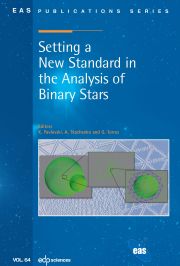Article contents
The power of principled bayesian methods in the study of stellar evolution
Published online by Cambridge University Press: 14 November 2014
Abstract
It takes years of effort employing the best telescopes and instruments to obtain high-quality stellar photometry, astrometry, and spectroscopy. Stellar evolution models contain the experience of lifetimes of theoretical calculations and testing. Yet most astronomers fit these valuable models to these precious datasets by eye. We show that a principled Bayesian approach to fitting models to stellar data yields substantially more information over a range of stellar astrophysics. We highlight advances in determining the ages of star clusters, mass ratios of binary stars, limitations in the accuracy of stellar models, post-main-sequence mass loss, and the ages of individual white dwarfs. We also outline a number of unsolved problems that would benefit from principled Bayesian analyses.
- Type
- Research Article
- Information
- European Astronomical Society Publications Series , Volume 65: The Ages of Stars , 2014 , pp. 267 - 287
- Copyright
- © EAS, EDP Sciences, 2014
References
- 3
- Cited by


